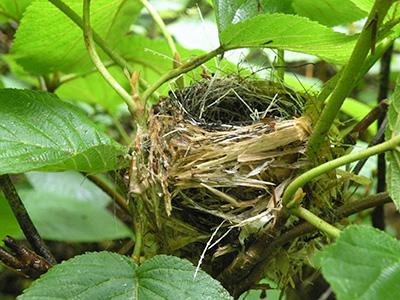Moose Herbivory: a Keystone Ecological Process in the Northern Forest Influencing Biodiversity

Moose browsing can change plant morphology, reduce tree growth and survival, and shift competitive balances. In the Northern Forest, some plants double as winter moose browse and spring/summer bird nesting sites. By browsing only twigs and buds exposed above snowpack, moose alter nesting habitat and reshape the architecture of the understory. Moose and black-throated blue warbler engage in a unique relationship through their use of shrubs, particularly hobblebush, in the forest understory.
NSRC researchers tested the effect of moose browsing on changes in distribution and branching patterns of understory shrubs, leading to changes in habitat selection for black-throated blue warbler. At the Hubbard Brook Experimental Forest in New Hampshire, researchers measured and modeled moose activity, understory composition and structure, and bird abundance. They also compared characteristics of hobblebush patches surrounding black-throated blue warbler nest sites with randomly selected adjacent patches.
Findings show that moose, by winter browsing, have a profound physical effect on hobblebush and black-throated blue warbler nest site selection. A moose browses a patch of hobblebush, and the plants develop more branches than they would otherwise. Within their own territories, black-throated blue warblers prefer these patches with more branches and greater visual obscurity for nesting. Since recolonizing the Northern Forest about 30 years ago, moose have become a charismatic symbol of the region. While moose and warbler ranges overlap, under forces of global change, they may not always, and understanding the community dynamics and habitat preferences of these species and others may be critical for long-term management as habitats and communities reorganize.
